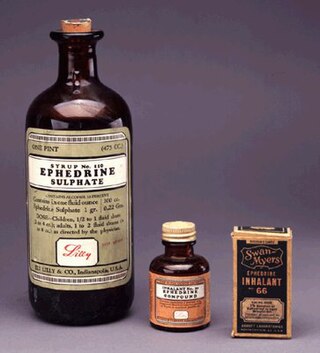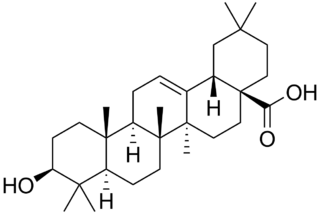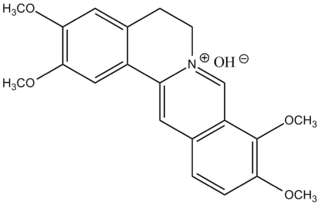
Alkaloids are a class of basic, naturally occurring organic compounds that contain at least one nitrogen atom. This group also includes some related compounds with neutral and even weakly acidic properties. Some synthetic compounds of similar structure may also be termed alkaloids. In addition to carbon, hydrogen and nitrogen, alkaloids may also contain oxygen or sulfur. Rarer still, they may contain elements such as phosphorus, chlorine, and bromine.

Ephedra is a medicinal preparation from the plant Ephedra sinica. Several additional species belonging to the genus Ephedra have traditionally been used for a variety of medicinal purposes, and are a possible candidate for the soma plant of Indo-Iranian religion. It has been used in traditional Chinese medicine, in which it is referred to as Ma Huang, for more than 2,000 years. Native Americans and Mormon pioneers drank a tea brewed from other Ephedra species, called "Mormon tea" and "Indian tea".

Phytochemistry is the study of phytochemicals, which are chemicals derived from plants. Phytochemists strive to describe the structures of the large number of secondary metabolites found in plants, the functions of these compounds in human and plant biology, and the biosynthesis of these compounds. Plants synthesize phytochemicals for many reasons, including to protect themselves against insect attacks and plant diseases. The compounds found in plants are of many kinds, but most can be grouped into four major biosynthetic classes: alkaloids, phenylpropanoids, polyketides, and terpenoids.

Passiflora incarnata, commonly known as maypop, purple passionflower, true passionflower, wild apricot, and wild passion vine, is a fast-growing perennial vine with climbing or trailing stems. A member of the passionflower genus Passiflora, the maypop has large, intricate flowers with prominent styles and stamens. One of the hardiest species of passionflower, it is both found as a wildflower in the southern United States and in cultivation for its fruit and striking bluish purple blooms.

Sida rhombifolia, commonly known as arrowleaf sida, is a perennial or sometimes annual plant in the Family Malvaceae, native to the Old World tropics and subtropics. Other common names include rhombus-leaved sida, Paddy's lucerne, jelly leaf, and also somewhat confusingly as Cuban jute, Queensland-hemp, and Indian hemp. Synonyms include Malva rhombifolia. It is used in Ayurvedic medicine, where it is known as kurumthotti.

Umbelliferone, also known as 7-hydroxycoumarin, hydrangine, skimmetine, and beta-umbelliferone, is a natural product of the coumarin family.

Uncaria tomentosa is a woody vine found in the tropical jungles of South and Central America. It is known as cat's claw or uña de gato in Spanish because of its claw-shaped thorns. The plant root bark is used in herbalism for a variety of ailments, and is sold as a dietary supplement.

Hydrocotyle umbellata is an aquatic plant that thrives in wet, sandy habitat. Its English common name is manyflower marshpennywort or dollarweed. It is native to North America and parts of South America. In Brazil it is known as acariçoba and has applications in herbal medicine with purported anxiolytic, analgesic and anti-inflammatory properties. It can also be found growing as an introduced species and sometimes a noxious weed on other continents. It is an edible weed that can be used in salads or as a pot herb.

Kuding is a particularly bitter-tasting Chinese infusion, which due to their similarities in appearance is derived from several plant species. The two most common plants used to make kuding are the wax tree species Ligustrum robustum and the holly species Ilex kaushue, the former being more commonly grown in Sichuan and Japan while the latter is most commonly grown and used in the rest of China. Tea produced from Ligustrum or many species of Ilex is caffeine-free, although not Ilex paraguariensis, the source of mate drank in South America.

Malvin is a naturally occurring chemical of the anthocyanin family.

Mesembrine is an alkaloid primarily derived from the plant Sceletium tortuosum, commonly known as kanna. This compound is noted for its psychoactive properties, particularly as a serotonin reuptake inhibitor, which contributes to its potential use in treating mood disorders and anxiety. Mesembrine has garnered interest in both traditional medicine and modern pharmacology, where it is explored for its effects on enhancing mood and cognitive function. The plant itself has a long history of use by indigenous peoples in southern Africa, who utilized it for its mood-enhancing and stress-relieving effects, often consuming it in various forms such as teas or chews.

Tridax procumbens, commonly known as coatbuttons or tridax daisy, is a species of flowering plant in the family Asteraceae. It is best known as a widespread weed and pest plant. It is native to the tropical Americas including Mexico, but it has been introduced to tropical, subtropical, and mild temperate regions worldwide. It is listed as a noxious weed in the United States and has pest status in nine states.

Oleanolic acid or oleanic acid is a naturally occurring pentacyclic triterpenoid related to betulinic acid. It is widely distributed in food and plants where it exists as a free acid or as an aglycone of triterpenoid saponins.

Mesembryanthemum cordifolium, formerly known as Aptenia cordifolia, is a species of succulent plant in the iceplant family. It is a creeping plant that forms a carpet of flat-growing perennial herbs in groups on the ground from a base. The genus name means middle-embryo flower in reference to the position of the ovary in the flower. The specific epithet is derived from Latin for heart-shaped leaves.

Palmatine is a protoberberine alkaloid found in several plants including Phellodendron amurense, Coptis Chinensis and Corydalis yanhusuo, Tinospora cordifolia, Tinospora sagittata, Phellodendron amurense, Stephania yunnanensis.

Eryngium foetidum is a tropical perennial herb in the family Apiaceae. Common names include culantro (Panama), cimarrón,recao, chardon béni (France), Mexican coriander, samat, bandhaniya, long coriander, Burmese coriander, sawtooth coriander, and ngò gai (Vietnam). It is native to Mexico, the Caribbean, and Central and South America, but is cultivated worldwide, mostly in the tropics as a perennial, but sometimes in temperate climates as an annual.

Clerodendrum infortunatum, known as bhat or hill glory bower, is a perennial shrub belonging to the family Lamiaceae, also sometimes classified under Verbenaceae. It is the type species among ~150 species of Clerodendrum. It is one of the most well-known natural health remedies in traditional practices and siddha medicine.
Alpinia nigra is a medium-sized herb belonging to the ginger family. The rhizome is well known in many Asian cultures as a medicinal and culinary item. In many Asian tribal communities it is a part of the diet along with rice.

Theacrine, also known as 1,3,7,9-tetramethyluric acid, is a purine alkaloid found in Cupuaçu and in a Chinese tea known as kucha. It shows anti-inflammatory and analgesic effects and appears to affect adenosine signalling in a manner similar to caffeine. In kucha leaves, theacrine is synthesized from caffeine in what is thought to be a three-step pathway. Theacrine and caffeine are structurally similar.





















